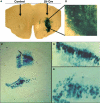The Use of Lentiviral Vectors and Cre/loxP to Investigate the Function of Genes in Complex Behaviors
- PMID: 20011219
- PMCID: PMC2790954
- DOI: 10.3389/neuro.02.022.2009
The Use of Lentiviral Vectors and Cre/loxP to Investigate the Function of Genes in Complex Behaviors
Abstract
The use of conventional knockout technologies has proved valuable for understanding the role of key genes and proteins in development, disease states, and complex behaviors. However, these strategies are limited in that they produce broad changes in gene function throughout the neuroaxis and do little to identify the effects of such changes on neural circuits thought to be involved in distinct functions. Because the molecular functions of genes often depend on the specific neuronal circuit in which they are expressed, restricting gene manipulation to specific brain regions and times may be more useful for understanding gene functions. Conditional gene manipulation strategies offer a powerful alternative. In this report we briefly describe two conditional gene strategies that are increasingly being used to investigate the role of genes in behavior - the Cre/loxP recombination system and lentiviral vectors. Next, we summarize a number of recent experiments which have used these techniques to investigate behavior after spatial and/or temporal and gene manipulation. These conditional gene targeting strategies provide useful tools to study the endogenous mechanisms underlying complex behaviors and to model disease states resulting from aberrant gene expression.
Keywords: PTSD; amygdala; fear; gene therapy; hippocampus; inducible knockout; lentivirus.
Figures








Similar articles
-
Conditional gene targeting in the mouse nervous system: Insights into brain function and diseases.Pharmacol Ther. 2007 Mar;113(3):619-34. doi: 10.1016/j.pharmthera.2006.12.003. Epub 2007 Jan 10. Pharmacol Ther. 2007. PMID: 17289150 Review.
-
Genetic manipulation of specific neural circuits by use of a viral vector system.J Neural Transm (Vienna). 2018 Jan;125(1):67-75. doi: 10.1007/s00702-016-1674-7. Epub 2017 Jan 5. J Neural Transm (Vienna). 2018. PMID: 28058503 Review.
-
Double transduction of a Cre/LoxP lentiviral vector: a simple method to generate kidney cell-specific knockdown mice.Am J Physiol Renal Physiol. 2015 Dec 15;309(12):F1060-9. doi: 10.1152/ajprenal.00251.2015. Epub 2015 Sep 16. Am J Physiol Renal Physiol. 2015. PMID: 26377795
-
Placenta-specific gene activation and inactivation using integrase-defective lentiviral vectors with the Cre/LoxP system.Genesis. 2009 Dec;47(12):793-8. doi: 10.1002/dvg.20563. Genesis. 2009. PMID: 19830817
-
Lentiviruses allow widespread and conditional manipulation of gene expression in the developing mouse brain.Development. 2013 Jul;140(13):2818-22. doi: 10.1242/dev.093823. Development. 2013. PMID: 23757413
Cited by
-
Neurocircuits to Behavior: The New Revolution.Harv Rev Psychiatry. 2017 Mar/Apr;25(2):47-49. doi: 10.1097/HRP.0000000000000152. Harv Rev Psychiatry. 2017. PMID: 28272129 Free PMC article. No abstract available.
-
15 years of genetic approaches in vivo for addiction research: Opioid receptor and peptide gene knockout in mouse models of drug abuse.Neuropharmacology. 2014 Jan;76 Pt B(0 0):204-17. doi: 10.1016/j.neuropharm.2013.08.028. Epub 2013 Sep 10. Neuropharmacology. 2014. PMID: 24035914 Free PMC article. Review.
-
More than Just a "Motor": Recent Surprises from the Frontal Cortex.J Neurosci. 2018 Oct 31;38(44):9402-9413. doi: 10.1523/JNEUROSCI.1671-18.2018. J Neurosci. 2018. PMID: 30381432 Free PMC article. Review.
-
From the neurobiology of extinction to improved clinical treatments.Depress Anxiety. 2014 Apr;31(4):279-90. doi: 10.1002/da.22214. Epub 2013 Nov 20. Depress Anxiety. 2014. PMID: 24254958 Free PMC article. Review.
-
Advances in Genetic Reprogramming: Prospects from Developmental Biology to Regenerative Medicine.Curr Med Chem. 2024;31(13):1646-1690. doi: 10.2174/0929867330666230503144619. Curr Med Chem. 2024. PMID: 37138422 Review.
References
-
- Abordo-Adesida E., Follenzi A., Barcia C., Sciascia S., Castro M. G., Naldini L., Lowenstein P. R. (2005). Stability of lentiviral vector-mediated transgene expression in the brain in the presence of systemic antivector immune responses. Hum. Gene Ther. 16, 741–75110.1089/hum.2005.16.741 - DOI - PMC - PubMed
-
- Asada H., Kawamura Y., Maruyama K., Kume H., Ding R.-G., Kanbara N., Kuzume H., Sanbo M., Yagi T., Obata K. (1997). Cleft palate and decreased brain gamma-aminobutyric acid in mice lacking the 67-kDa isoform of glutamic acid decarboxylase. Proc. Natl. Acad. Sci. U.S.A. 94, 6496–649910.1073/pnas.94.12.6496 - DOI - PMC - PubMed
LinkOut - more resources
Full Text Sources
Molecular Biology Databases

